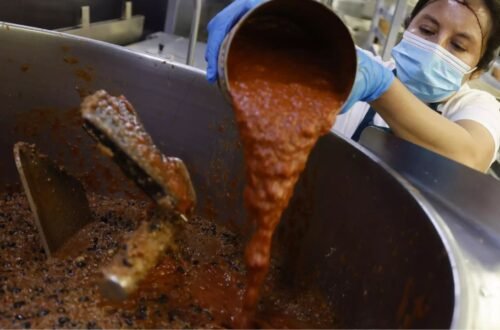Food-Wasting Countries: Food is something we all need every day — but did you know that huge amounts of it go to waste around the world? It may seem shocking, but millions of tonnes of edible food are thrown away every year, even while many people suffer from hunger.
In this article, we’ll explore the top 10 food-wasting countries, why food waste matters, and how we can do better. The goal is to help you understand this problem in a simple way and feel empowered to act.
Top 10 Food-Wasting Countries
Below is a table showing the top 10 countries that waste the most food, along with their annual waste and average waste per person.
| Rank | Country | Annual Food Waste (million tonnes) | Waste per Person (kg/year) |
|---|---|---|---|
| 1 | China | 108.6 | 76 |
| 2 | India | 78.1 | 55 |
| 3 | United States | 24.7 | 73 |
| 4 | Brazil | 20.2 | 94 |
| 5 | Indonesia | 14.7 | 53 |
| 6 | Germany | 6.5 | 78 |
| 7 | Russia | 4.8 | 33 |
| 8 | Philippines | 2.9 | 26 |
| 9 | South Africa | 2.8 | 47 |
| 10 | Ghana | 2.8 | 84 |
What the Numbers Tell Us
China
China is at the top of this list, throwing away 108.6 million tonnes of food every year. On average, each person wastes about 76 kg annually. Because China has a huge population, its total waste is enormous.
India
India is second, with 78.1 million tonnes wasted annually. Indians waste about 55 kg per person yearly. Though the per person figure is lower than in some countries, the large population makes the total enormous. Problems like poor storage, transport losses, and lack of supply chain infrastructure add to the issue.
United States
In the US, people waste around 24.7 million tonnes of food yearly. The per person rate is very high at 73 kg. Causes include overbuying, large portion sizes, and consumer habits.
Brazil
Brazil’s food waste totals 20.2 million tonnes, with an average of 94 kg wasted per person — one of the highest per person rates. Households, restaurants, and stores all contribute.
Indonesia
Indonesia discards 14.7 million tonnes every year. Each person wastes about 53 kg. Big challenges include distribution, education, and income differences.
Germany
Despite strong environmental policies, Germany still wastes 6.5 million tonnes. Each German discards about 78 kg of food yearly. Retail and household waste are significant areas to improve.
Russia
Russia’s food waste is about 4.8 million tonnes, or 33 kg per person. Storage losses, poor buying habits, and distribution inefficiencies are key factors.
Philippines
The Philippines wastes 2.9 million tonnes yearly, around 26 kg per person. Infrastructure, awareness, and education gaps make this problem hard to fight.
South Africa
South Africa discards 2.8 million tonnes, which is about 47 kg per person. Food insecurity and waste happen side by side — making the issue stark.
Ghana
Ghana also wastes 2.8 million tonnes annually — each person wastes 84 kg. Even though Ghana has food scarcity in parts, rising consumerism and poor systems contribute to waste.
Why These Countries Waste So Much
Several common reasons show up again and again:
- Large population: Countries like China and India have so many people that even small per-person waste adds up.
- Poor storage and infrastructure: Lack of cold chains, weak roads, and bad packaging lead to spoilage.
- Consumer habits: Throwing away leftovers, buying more than needed, discarding “ugly” food.
- Retail practices: Shops rejecting produce that looks imperfect, overstocking.
- Lack of awareness & education: Many don’t realize how big waste is or how to reduce it.
What Can Be Done to Reduce Food Waste?
Here are some steps that individuals, communities, and governments can take:
- Plan meals and buy only what you need.
- Use leftovers smartly.
- Store food properly (use airtight containers, cool places).
- Support stores that sell “ugly” produce at lower price.
- Build better storage, refrigeration, and transport systems.
- Educate people about food waste and climate impact.
- Use apps or platforms to share surplus food.
- Change policies to encourage donation and reduce waste fines.
Even small changes by many people can add up to huge improvements.
Food waste is a major global challenge—affecting our environment, economy, and hunger crisis. From China’s massive waste to Ghana’s rising losses, every country on the list shows that both rich and poor nations struggle with it.
But the good news is that we all can help: by changing habits, supporting better systems, and learning more. When fewer people waste food, we can reduce emissions, save money, and help feed those in need. Let’s start today by caring about every meal we have.
FAQs
What counts as “food waste”?
Food waste means edible food that is thrown away — at homes, shops, or during transport — instead of being eaten.
Which sector wastes the most food?
Households (homes) are among the biggest waste makers, but retail, restaurants, and supply chains also cause large losses.
Can individual actions really make a difference?
Yes. If many people reduce waste even a little, the total impact is big — we can save money, reduce emissions, and help others get enough food.









